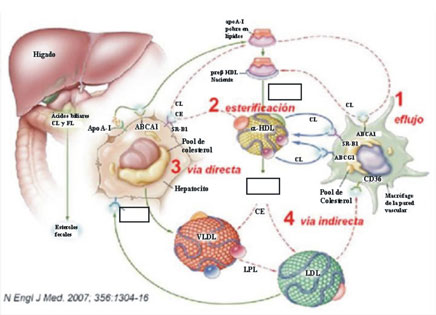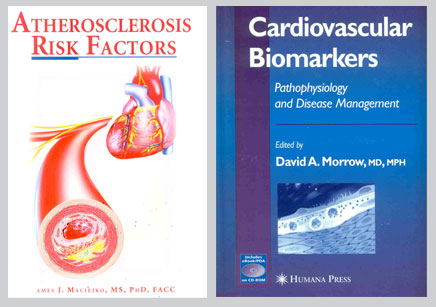Servicio
de Apoyo Científico-Técnico al Profesional
Modulación del colesterol HDL y su impacto con el manejo del riesgo cardiovascular
Resumen científico.
Ferns Gordon and Keti Vuyolethu. HDL-cholesterol modulation and its impact on the management of cardiovascular risk. Ann Clin Biochem 2008; 45: 122-128.
Hay una evidencia epidemiológica fuerte que el colesterol HDL (HDL-C) es un factor cardiovascular de riesgo independiente. Es común en la población en general encontrar los niveles de HDL-C bajos, y es notable en el síndrome metabólico, la prevalencia que se incrementa globalmente. La importancia de HDL-C como un factor de riesgo coronario es aceptado generalmente, y ha sido incorporado en la mayoría de los cálculos de riesgos. Hay diversas causas de la disminución de HDL-C, incluyendo anormalidades genéticas raras, y condiciones mas comunes asociadas con el estilo de vida y terapia farmacológica. No todos éstos están asociados con un incremento en la enfermedad de riesgo coronario. Un mejor entendimiento del metabolismo de HDL y de los mecanismos por los cuales puede ejercer sus efectos protectores han revelado porque éstos deben ser la causa del beneficio. Nuevos blancos terapéuticos fueron también identificados permitiendo un incremento en el HDL-C en pacientes con bajos niveles de éste. De cualquier modo, estudios clínicos de punto final bien planeados siguen siendo necesarios para permitir establecer un valor absoluto determinado para HDL-C en pacientes con alto riesgo cardiovascular.
Bibliografía.
En inglés.
1- Kapur NK, Ashen D, Blumenthal RS. High density lipoprotein cholesterol: an evolving target of therapy in the management of cardiovascular disease. Vasc Health Risk Manag. 2008; 4(1): 39-57.
2-Hoening MR. Implications of the obesity epidemic for lipid-lowering therapy: non-HDL cholesterol should replace LDL cholesterol as the primary therapeutic target. Vasc Health Risk Manag. 2008; 4(1): 143-56.
3- Hettema ME, Zhang D, de Leeuw K, Stienstra Y, Smit AJ, Kallenberg CG, Bootsma H. Early atherosclerosis in systemic sclerosis and its relation to disease or traditional risk factors. Arthritis Res Ther. 2008; 10(2): R49.
4- Rafidah HM, Azizi A, Noriah MN. Blood pressure variability and arterial elasticity in hyperlipidaemic subjects. Singapore Med J. 2008 Apr; 49 (4): 297-303.
5-Merrill RM, Aldana SG. Cardiovascular risk reduction and factors influencing loss to follow-up in the coronary health improvement project. Med Sci Monit. 2008 Apr; 14 (4): PH17-25
6- Akishita M, Hashimoto M, Ohike Y, Ogawa S, Iijima K, Eto M, Ouchi Y. Association of plasma dehydroepiandrosterone-sulfate levels with endothelial function in postmenopausal women with coronary risk factors.
7- Kathiresan S, Melander O, Anevski D, Giuducci C, Burtt NP, Roos C, Hirschhorn JN, Berglund G, Hedbland B, Groop L, Altshuler DM, Newton-Cheh C, Orho-Melander M. Polymorphisms associated with cholesterol and risk of cardiovascular events. N Engl J Med. 2008 Mar 20; 358 (12): 1240-9
8- Graham KA, Cho H, Brownley KA, Harp JB. Early treatment-related changes in diabetes and cardiovascular disease risk markers in first episode psychosis subjects. Schizophr Res. 2008 Apr; 101 (1-3): 287-94.
9- Ferns G, Keti V. HDL-cholesterol modulation and its impact on the management of cardiovascular risk. Ann Clin Biochem 2008; 45: 122-128
En español y portugués.
10- Pituelli Suárez N, Corbera Prin M, Lioi Luciani S, Turco Pilottó M, D´Arrigo Dri M, Rosillo Politti I. Prevalence of risk factors: obesity and lipid profile. An Pediatr (Barc). 2008 Mar; 68 (3): 257-63.
11- Alonso JEF, Ariza IDS. Elevando el colesterol HDL: ¿Cuál es la mejor estrategia?. Rev Assoc Med Bras; 54(4): 369-376.
12-Rodrigues TFF, Philippi ST. Nutritional evaluation and cardiovascular risk in executives submitted to a check-up. Rev Assoc Med Bras; 54(4): 322-327.
13-Sanches LB, Silva IT da, Paz AFS, Fisberg M, Cintra, IP, Villar BS, Damasceno NRT. Anti-oxLDL autoantibodies and their correlation with lipid profile and nutritional status in adolescents. J pediatr. (Rio J); 84(3): 258-263.
14- Forti N, Diament J. Apolipoprotinas B e A-1: factores de risco cardiovascular? Rev Assoc Med Bras ; 53(3): 276-282.
Agudice su ingenio

Lo invitamos a completar los cuadros que se encuentran en blanco del esquema correspondiente al metabolismo del colesterol HDL que se encuentra debajo.
CL, Colesterol libre; FL, Fosfolípidos; CE, Esteres de colesterol; LCAT, lecitin colesterol aciltransferasa; CETP, proteína de transferencia de ester de colesterol; LPL, lipoprotein lipasa; Rc-LDL, receptor de la molécula de LDL; SR-B1, receptor scavenger (basura) B1; apoA-1, apolipoproteína AI; ABCA1, transportador de colesterol.
NOTA: Para solicitar los artículos o la solución de Agudice su ingenio, por favor comuníquese con el SACT a bibliote@fbpba.org.ar
Su opinión nos interesa.
Le agradeceremos que nos haga llegar sus comentarios y sugerencias respecto a esta sección del Servicio de Apoyo Científico Técnico al Profesional. Puede hacerlo al correo electrónico bibliote@fbpba.org.ar
Consulte nuestros servicios
- Asesoría profesional en metodología de la investigación
- Biblioteca
- Taller documental (manuscritos, posters y resúmenes de congresos, CV, presentaciones orales)
- Capacitación en estos temas

NOVEDADES
Adquisición de nuevos libros. Los siguientes libros han ingresado en la colección del SACT:

Atherosclerosis risk factors
Maciejko, James J. – USA. Editorial American Association for Clinical Chemistry, Inc. 2003 – xi, 192p : il. : 22,5 x 15 cm.
Contiene:
Capítulo 1: The cardiovascular System. Cardiovascular anatomy and physiology. Blood vessels. Lymphatic vessels: the body´s secondary drainage system. Endothelial cells. Arteriosclerosis: diseases that thicken and harden the arterial wall. – Capítulo 2: The vascular biology of atherosclerosis. Pathogenesis of atherosclerosis-intense research. Origin and progression of atherosclerosis. - Capítulo 3: The concept of risk. “Risk factors” and descriptive epidemiological studies. Analytical studies: determining causality of risk factors. The connection between reducing cholesterol and reducing clinical atherosclerotic events. Risk factors classification. - Capítulo 4: Inflammatory/infection factors. Inflammatory markers. Infectious agents. Capítulo 5: Serum markers. Homocysteine. Triglycerides. Low HDL-Cholesterol . Small, dense LDL, Lipoprotein (a).
Cardiovascular biomarkers
David A. Marrow – Totowa, New Jersey. Editorial Human Press Inc. 2006 – xvii, 620p : il. col. : 26 x 18,5 cm.
Contiene:
Biomarkers of myocardial necrosis: past, present, and future. – Analytical issue for the clinical use of cardiac troponin. – Definig myocardial infarction. – Biomarkers in the emergency department: rapid diagnosis and triage. – Cardiac troponin for risk assessment and management of non-ST-elevation acute coronary syndrome. – Biomarkers of necrosis for risk assessment and management of ST-elevation myocardial infarction. – Cardiac troponin after revascularization procedures. – Biomarkers of necrosis in heart failure: past present, and future directions. – Is there a role for cardiac troponin and other biomarkers in patients with pulmonary embolism?. – Cardiac troponin in conditions others than acute coronary syndromes. – Degradation of cardiac troponins: implications for clinical practice. – Developing a marker of ischemia: Clinical and research challenges. – Emerging biomarkers of myocardial ischemia. – Inflammation in cardiovascular disease: the biological basis of inflammatory biomarkers. – Analytic issues for the clinical use of C-reactive protein. – C-reactive protein as a tool for risk assessment in primary prevention. - High-sensitivity c-reactive protein for risk assessment in acute coronary syndromes. – Beyond c-reactive protein: novel markers of vascular inflammation. – Biomarkers of inflammation: implications in patients with heart failure. – Biomarkers of infection and risk of coronary heart disease. – Biology of the natriuretic peptides. – Analytic issues for the clinical use of B-type natriuretic peptide. – Clinical use of natriuretic peptides for the diagnosis and management of heart failure. – Natriuretic peptides in acute and chronic coronary artery disease. – Novel markers of hemodynamic stress. – Clinical and research applications of markers of thrombosis. – Measures of platelet activation and aggregation. – Monocyte-platelet aggregates in patient with ischemic heart disease. – Measurement of atherogenic lipoproteins in cardiovascular risk assessment. – Lipoprotein-associated phospholipase A2 and other lipid-realted biomarkers in cardiovascular disease. – A multimarker approach to evaluation of patients with acute coronaty syndrome. – Cardiac biomarkers by point-of-care testing. – Proteomics and cardiovascular biomarker discovery. – Genetic markers in cardiovascular disease.
|
|


